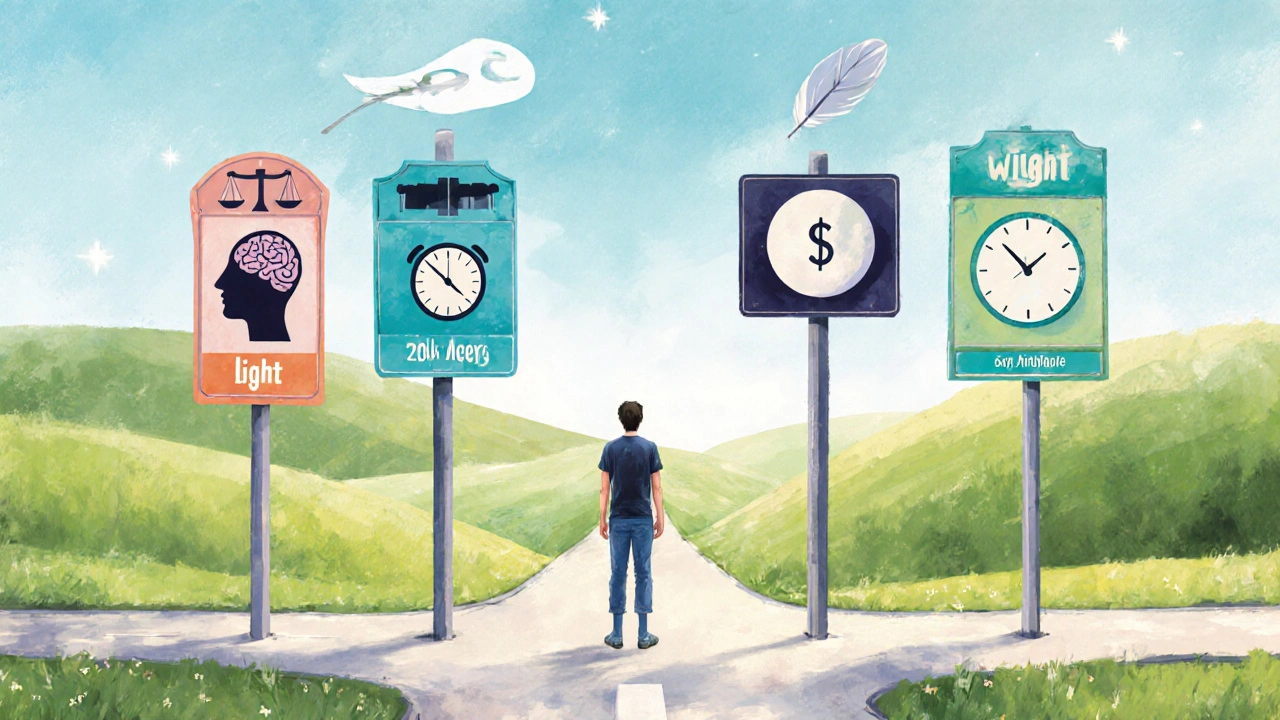Antipsychotic Medication Selector
Use this tool to compare key features of antipsychotics based on your clinical needs.
Select Your Priority Areas
TL;DR
- Solian (Amisulpride) targets dopamine D2/D3 receptors with a dose‑dependent profile.
- Risperidone and Aripiprazole are the closest rivals in efficacy, but differ in side‑effect patterns.
- Quetiapine offers sedation benefits, while Haloperidol is the cheapest but carries higher movement‑disorder risk.
- Cost in Australia ranges from AU$30/month (Haloperidol) to over AU$200/month (Olanzapine).
- Choosing the right drug hinges on symptom profile, side‑effect tolerance, and personal budget.
When it comes to treating schizophrenia or related psychoses, Solian is the trade name for amisulpride, a selective dopamine‑D2/D3 antagonist. It’s been on the Australian market since the early 2000s and is often praised for its low propensity to cause sedation. Yet patients and prescribers constantly wonder how it stacks up against other options. This guide walks through the science, real‑world pros and cons, and key decision points so you can see whether Solian truly fits your needs or if another antipsychotic might serve you better.
What is Solian (Amisulpride)?
Amisulpride belongs to the class of atypical antipsychotics, but it’s a bit of an outlier. At low doses (50‑300mg/day) it preferentially blocks presynaptic dopamine D2/D3 receptors, which can actually boost dopamine release and help with negative symptoms like flat affect or social withdrawal. At higher doses (400‑800mg/day) it blocks postsynaptic receptors, reducing positive symptoms such as hallucinations.
How Solian Works: The Mechanism in Plain English
Think of dopamine as a messenger that tells the brain to “pay attention.” In schizophrenia, this messenger goes a bit haywire. Solian’s job is to quiet the over‑active channels without completely shutting down the whole system. By targeting both D2 and D3 receptors, it provides a nuanced balance that many other antipsychotics don’t achieve.
When Doctors Prescribe Solian
The drug is officially approved for:
- Schizophrenia in adults.
- Depressive episodes in bipolar disorder (off‑label in some states).
- Persistent negative symptoms when other agents fall short.
Because it’s less sedating, many clinicians reserve Solian for patients who need to stay sharp for work or study.
Key Benefits and Drawbacks of Solian
Benefits
- Lower risk of weight gain compared with olanzapine or clozapine.
- Minimal anticholinergic effects - fewer dry mouth and constipation complaints.
- Useful at low doses for negative symptom relief.
Drawbacks
- Higher incidence of prolactin‑related side effects (e.g., menstrual changes, galactorrhea).
- Can cause QT‑interval prolongation - clinicians monitor ECGs in at‑risk patients.
- Not as effective for acute agitation as some high‑potency agents.

Common Alternatives: Quick Snapshot
Below are the most frequently considered rivals. Each entry includes a brief definition with microdata markup to help search engines understand the topic.
Risperidone is a second‑generation antipsychotic that blocks D2 receptors and serotonin 5‑HT2A receptors, offering strong control of positive symptoms.
Quetiapine is known for its sedating properties and is often used when insomnia or anxiety accompany psychosis.
Aripiprazole acts as a dopamine partial agonist, meaning it can both stimulate and block dopamine depending on the brain region.
Olanzapine delivers powerful symptom control but is notorious for causing weight gain and metabolic issues.
Haloperidol is a first‑generation (typical) antipsychotic with strong D2 blockade, cheap and effective for acute psychosis but carries a high risk of movement disorders.
Head‑to‑Head Comparison
| Medication | Typical Daily Dose | Primary Mechanism | Efficacy (PANSS reduction) | Common Side Effects | Approx. Monthly Cost (AU$) |
|---|---|---|---|---|---|
| Solian (Amisulpride) | 50‑800mg | D2/D3 antagonist (dose‑dependent) | ≈30% reduction | Hyperprolactinaemia, QT prolongation | ≈120 |
| Risperidone | 1‑6mg | D2 & 5‑HT2A antagonist | ≈35% reduction | Weight gain, akathisia | ≈140 |
| Quetiapine | 300‑800mg | H1‑histamine & 5‑HT2A antagonist | ≈25% reduction | Sedation, orthostatic hypotension | ≈110 |
| Aripiprazole | 10‑30mg | D2 partial agonist | ≈28% reduction | Insomnia, akathisia | ≈180 |
| Olanzapine | 5‑20mg | D2 & 5‑HT2A antagonist | ≈38% reduction | Weight gain, metabolic syndrome | ≈200 |
| Haloperidol | 5‑20mg | High‑potency D2 antagonist | ≈30% reduction | Extrapyramidal symptoms, tardive dyskinesia | ≈30 |
Decision Criteria: How to Pick the Right Drug
Every patient’s situation is unique, but most choices boil down to four practical questions.
- What symptoms dominate? Positive symptoms (hallucinations) respond well to strong D2 blockers like haloperidol or olanzapine. Negative symptoms (social withdrawal) may improve with low‑dose Solian or aripiprazole.
- How sensitive are you to side effects? If weight gain is a deal‑breaker, dodge olanzapine. If prolactin issues are intolerable, steer clear of Solian.
- What’s your budget? Generic haloperidol is the cheapest; newer agents (aripiprazole, olanzapine) can strain a tight wallet.
- Any cardiac or metabolic concerns? QT‑prolongation risk pushes you toward risperidone or quetiapine, while diabetes risk advises caution with olanzapine.
Use this checklist with your prescriber to narrow down the shortlist.
Practical Tips & Common Pitfalls
- Start low, go slow: most clinicians begin Solian at 50mg and titrate up every week. Jumping to 800mg can trigger sudden prolactin spikes.
- Monitor labs regularly: fasting glucose, lipid panel, and prolactin levels give early warning signs.
- Don’t mix antipsychotics without clear reason. Polypharmacy can mask side‑effect profiles and complicate dosing.
- Consider formulation: long‑acting injectables (e.g., risperidone microspheres) improve adherence for patients who miss oral doses.
- Stay alert to drug-food interactions. High‑fat meals can slightly increase absorption of olanzapine, but have little effect on Solian.
Frequently Asked Questions
Can Solian cause weight gain?
Weight gain is generally modest with Solian compared to olanzapine or clozapine, but some patients report a few kilograms after several months.
Is Solian safe for younger adults (18‑25)?
Yes, it’s approved for adults 18years and older. However, clinicians watch prolactin levels closely in this age group because hormonal changes can be more noticeable.
How does Solian compare to Haloperidol for acute agitation?
Haloperidol works faster and is more potent for severe agitation, but it carries a higher risk of movement disorders. Solian is slower to act and is usually reserved for stable maintenance rather than emergency calming.
Do I need regular ECGs while on Solian?
If you have a history of heart rhythm issues or are on other QT‑prolonging meds, your doctor will likely order an ECG at baseline and periodically thereafter.
Can I switch from Risperidone to Solian without a washout period?
A direct switch is possible under medical supervision. The usual practice is to taper risperidone over a week while introducing a low dose of Solian, then titrate up to the target dose.
Next Steps
If you’re weighing Solian against the alternatives, start by listing your top three priorities (symptom control, side‑effect profile, cost). Bring that list to your psychiatrist or GP. Ask for a side‑by‑side look at the table above, and request lab monitoring plans that match the medication you choose.
Remember, medication is only one piece of the puzzle. Therapy, lifestyle, and a solid support network often make the difference between a good response and a mediocre one.


The pharmacodynamic architecture of amisulpride, marketed as Solian, exemplifies a dose‑dependent bifurcation in dopaminergic modulation that is seldom appreciated in mainstream psychopharmacology. At sub‑therapeutic thresholds (50‑300 mg/day), the agent preferentially antagonizes presynaptic D2/D3 autoreceptors, paradoxically augmenting dopamine release in mesocortical pathways, thereby ameliorating negative symptomatology associated with schizophrenia. Escalation to higher dosages (400‑800 mg/day) inverts this mechanism, effecting classic post‑synaptic D2/D3 blockade, which attenuates positive psychotic phenomena such as hallucinations and delusions. This dichotomous profile distinguishes amisulpride from other atypicals that exhibit a more monolithic antagonism across receptor subtypes. From a systems‑level perspective, the selective affinity for D3 receptors confers a theoretical advantage in mitigating reward‑circuit dysregulation, a hypothesis that aligns with recent neuroimaging data demonstrating restored ventral striatal activity in patients receiving low‑dose amisulpride. Moreover, the drug’s negligible antihistaminergic and anticholinergic actions reduce the propensity for sedation and cognitive blunting, side effects that frequently compromise functional recovery. Nonetheless, the endocrine sequelae, notably hyperprolactinaemia, warrant vigilant monitoring given the drug’s propensity to disinhibit hypothalamic dopamine tone. QT‑interval prolongation, albeit infrequent, necessitates baseline electrocardiographic assessment in individuals with pre‑existing cardiac risk factors. Economically, the cost burden in the Australian market (~AU$120/month) positions Solian as a mid‑range option, more affordable than olanzapine yet pricier than generic haloperidol, thereby influencing formulary decisions in public health systems. Comparative efficacy metrics, such as PANSS reduction percentages, suggest that while solian approximates the 30 % reduction observed with haloperidol, it trails risperidone’s 35 % and olanzapine’s 38 % benchmarks. Consequently, clinicians must weigh the trade‑offs between nuanced negative symptom relief and modest positive symptom suppression when selecting amisulpride. In sum, the agent’s receptor‑specificity, dose‑responsive dynamics, and side‑effect profile render it a valuable tool in the psychiatrist’s armamentarium, particularly for patients whose clinical picture is dominated by negative symptoms and who demonstrate intolerance to the metabolic sequelae of more lipophilic antipsychotics. However, its utility is circumscribed by endocrine monitoring demands and potential cardiac considerations, underscoring the necessity for individualized risk‑benefit assessments in each therapeutic context.